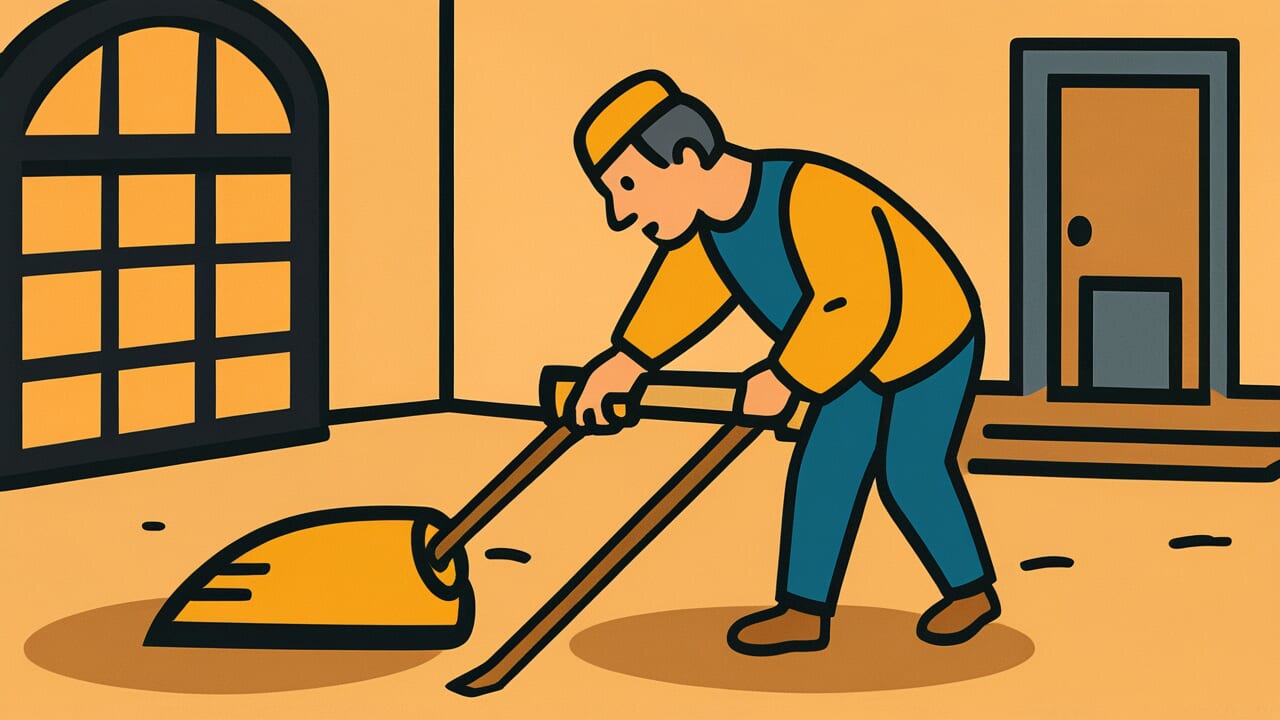How to Read “Sweeping a square room in circles”
Shikakuna zashiki wo maruku haku
Meaning of “Sweeping a square room in circles”
“Sweeping a square room in circles” means doing things halfway and cutting corners.
The image comes from someone sweeping a square room but avoiding the troublesome corners. They only clean the center in circular motions.
This proverb criticizes people who don’t do what they should. They only fix the surface while avoiding the real work.
People use this saying to warn against doing only the easy parts of a job. It points out when someone avoids difficult or troublesome tasks.
You might look like you’re working, but you’re not tackling what really needs to be done.
Even today, this applies to many situations. Someone might skip important parts of a report. A cleaner might ignore hard-to-reach places.
People avoid dealing with the real problem and settle for superficial solutions. This proverb perfectly captures that behavior.
It describes someone who pretends to work hard but is actually slacking off. The saying remains relevant because this pattern still happens everywhere.
Origin and Etymology
No clear written records explain the origin of this proverb. However, the phrase itself suggests it came from everyday cleaning in traditional Japanese homes.
Square rooms are typical in Japanese houses. Tatami mats cover the floor in these rooms.
If you don’t sweep all the way to the corners, dust and dirt pile up there. Sweeping in circles means you only clean the center area.
You move your broom in circular motions and skip the four corners. This makes it look like you cleaned, but the job isn’t really done.
Documents from the Edo period describe daily life among common people. They show that cleaning quality reflected a person’s character and work attitude.
Cleaning wasn’t just about removing dirt. It measured someone’s honesty and sense of responsibility.
The phrase “treating something square as if it were round” creates a visual image. It shows someone ignoring the true nature of their task and taking the easy way out.
This reflects the Japanese value of thoroughness and perfectionism. Our ancestors had sharp eyes for human nature.
They saw a person’s true character in small, everyday actions. This proverb shows their wisdom.
Usage Examples
- His proposal is like sweeping a square room in circles – the crucial budget section remains vague
- If you sweep a square room in circles on your cleaning duty, the teacher will scold you
Universal Wisdom
“Sweeping a square room in circles” reveals a fundamental human conflict. We struggle between wanting to take the easy way and needing to fulfill our responsibilities.
Everyone wants to avoid troublesome tasks if possible. Sweeping all the way to the corners takes effort.
But if you skip that effort and only sweep the center, it looks like you cleaned. This temptation to “fix only appearances” has troubled humans across all ages.
This proverb endures because it perfectly visualizes the psychology of cutting corners. Treating something square as round shows a contradictory action.
It represents ignoring the true purpose and prioritizing your own convenience.
What’s interesting is that this proverb doesn’t just criticize laziness. It reveals the structure of deception itself.
People who cut corners don’t completely skip work. They try to maintain some appearance of completion.
This “pretending to work” shows both human cunning and human weakness at the same time.
Our ancestors observed these movements of the human heart. They found them in the simple act of sweeping.
They left us this universal lesson through everyday experience.
When AI Hears This
Dirt accumulates easily in the corners of square rooms. So if you sweep in circles, the center gets clean but the corners stay dirty.
In mathematics, this is called reaching a “local optimum.” Looking at just that spot, it seems you can’t improve anymore. But actually, the overall solution remains incomplete.
The same problem happens in machine learning. When AI learns, it might focus only on reducing immediate errors.
At some point, it judges “this can’t get any better.” But actually, a much better answer exists somewhere else.
We call this the “local optimum trap.” Someone sweeping in circles thinks “the center is clean, no room for improvement.”
But if you change your perspective, you see the corners as areas needing improvement.
What’s fascinating is this: the pattern of human corner-cutting matches the pattern of advanced AI failure. They share the same mathematical structure.
Both succeed at “maximizing the evaluation function in front of them.” But both lose sight of “the function they should really maximize.”
Sweeping in circles gives you the best effort-to-effect ratio. But it’s not optimal for the true objective function: “cleanliness of the entire room.”
Human corner-cutting and AI learning failures fall into the same trap. Both make the mistake of setting the wrong evaluation criteria.
Lessons for Today
This proverb teaches modern people about “the power to see things through.” We face countless small choices every day.
In each one, we decide whether to do it properly or cut corners.
Modern society emphasizes efficiency and speed. Sometimes doing things “good enough” seems like the smart choice.
But this proverb teaches us differently. What truly matters is the integrity to finish what you start.
People who sweep all the way to the corners don’t cut corners even where no one watches. That attitude builds your character and earns trust from others.
Small acts of cutting corners eventually lead to major losses of credibility.
Today, you might face moments in your work or studies where you think “this is good enough.” When that happens, remember this square room.
Paying attention to every corner is ultimately the shortest path to improving yourself.



Comments